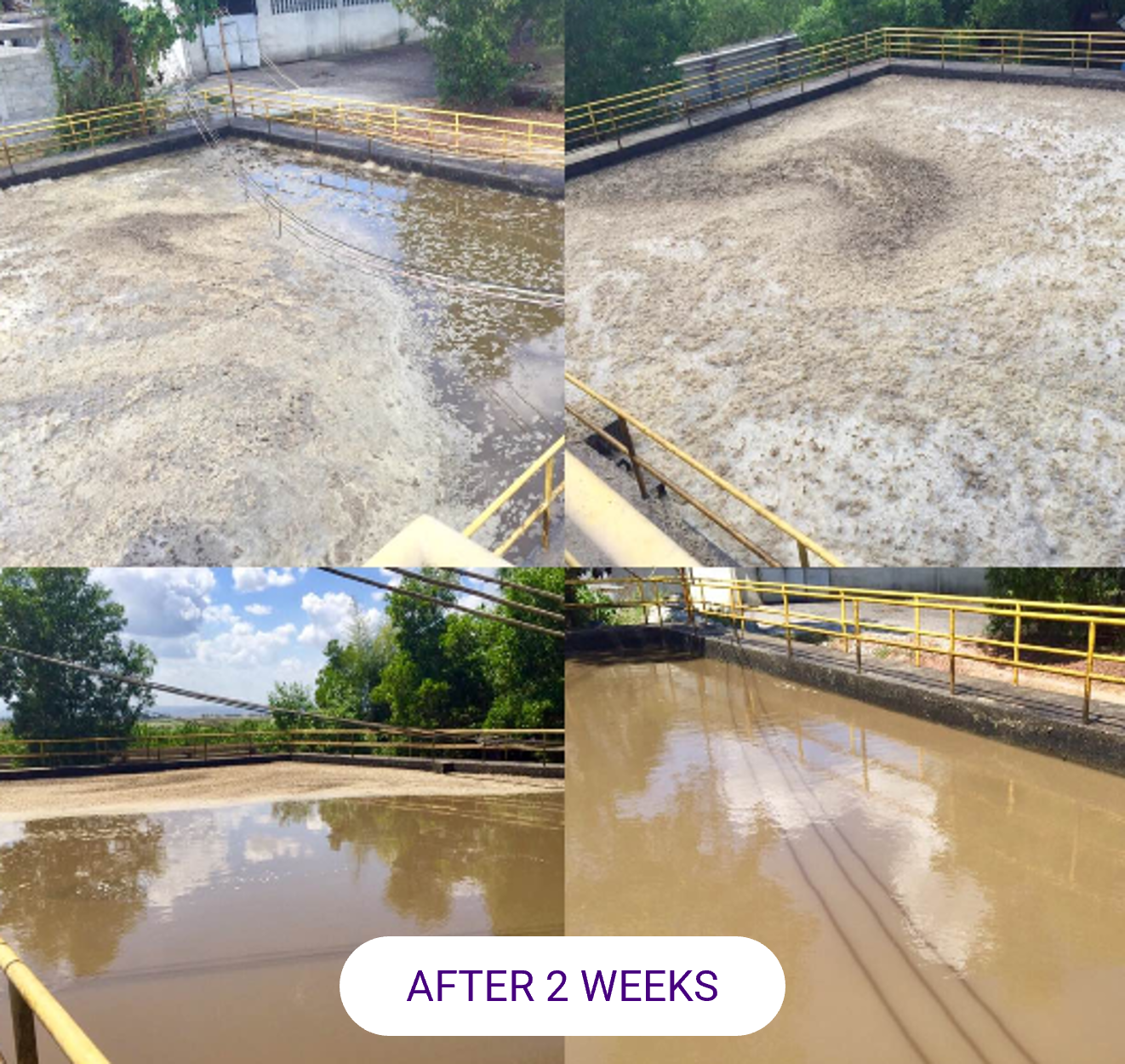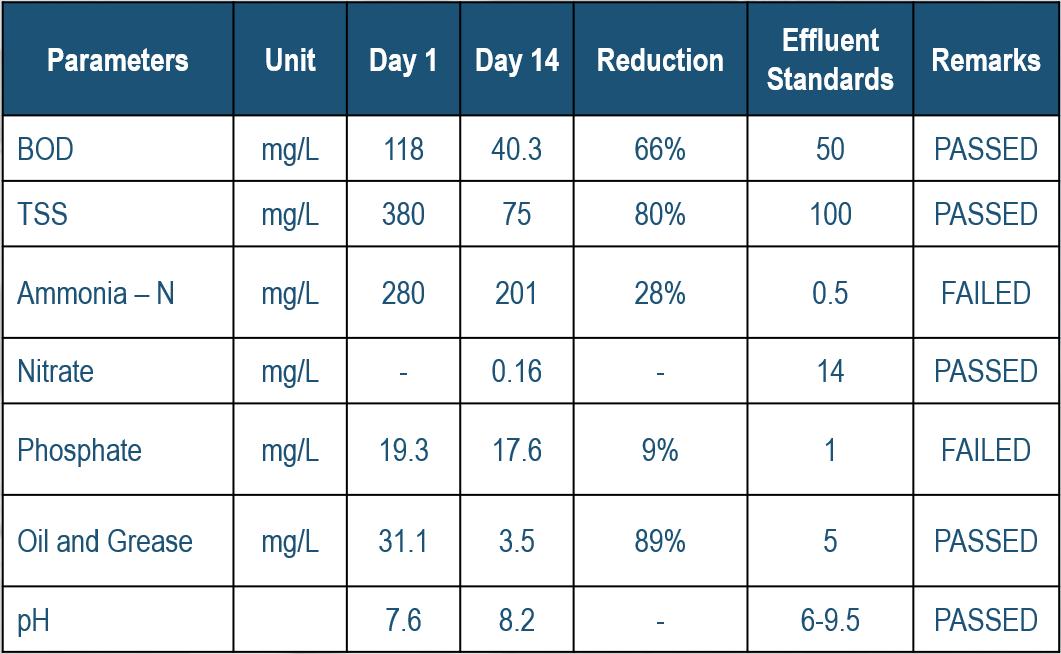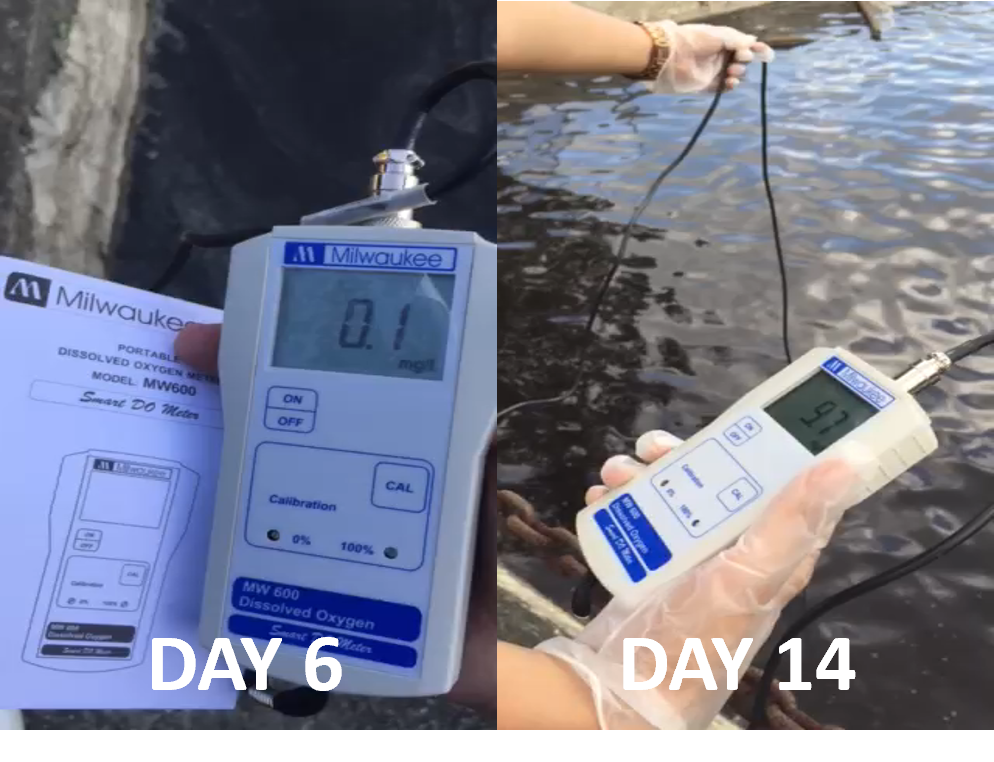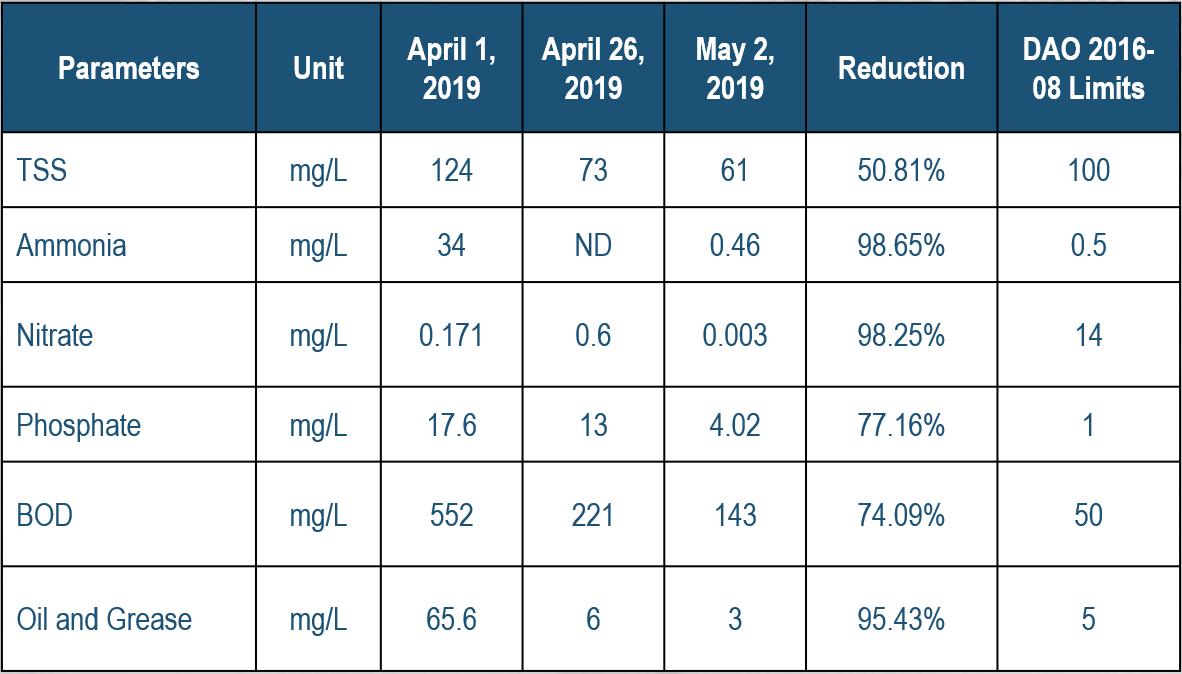

DRESSING PLANTS
CASE 1
LOCATION
San Nicolas, Tarlac, Philippines
WASTEWATER TREATMENT SYSTEM
Sequencing Batch Reactor (SBR)
WASTEWATER GENERATION / CAPACITY
2000 cu.m per day (maximum)
The dressing plant is located in San Nicolas, Tarlac City. This is one of the biggest toll processing in the area with a capacity of 80,000 birds per day. The wastewater generation is at around 1,300 to 2,000 cubic meters per day being served with an SBR Type (Sequencing Batch Reactor) Wastewater Treatment Facility. There are three (3) units of SBR operating 24 hours, with three (3) cycles each day.
Specific Problems and Issues
The problems encountered for the facility were high concentrations of BOD, TSS, Fats, oil and grease plus nutrient concentrations as to Ammonia, Nitrate and Phosphates. Another major concern was the sludge accumulation to each SBR Tank thereby poor treatment manifestations and poor effluent quality.
Our Solutions
These issues could be addressed by bioremediation. It is a process of treatment and breaking down of environmental pollutants by microbial metabolism. In the recent years, biotechnological approaches that could carry out remediation has gained a great deal of attention since it’s a natural process that is cost effective and would require less energy and manual supervision compared to other technologies.
The Microbe-Lift® series is an advanced bioremediation technology that contains a complete consortium of Bacterial cultures that degrades almost all kinds of organic waste in your wastewater which helps improve its quality and can enhance composting efficiency of biodegradable wastes. Microbe-Lift contains a wide array of bacteria that can immediately multiply upon contact with polluted water. Moreover, these bacteria produce enzymes responsible for organic degradation.
MICROBE-LIFT/IND (Hi-Count) is used to address the failed effluent parameters of the Dressing Plant. MICROBE-LIFT/IND a highly active liquid culture consortium designed specifically for use in practically all environmental applications. Microbe Lift IND select cultures promotes increased biological degradation capabilities in all types of designs of biological wastewater systems, lagoons and polluted environments. Microbe Lift IND consortium is very effective in degrading hard to degrade complex compounds such as fatty acids, various chemical compounds, hydrocarbons and fibrous matters that indigenous bacteria often unable to degrade them, hence result in system performance deficiency.
Visual Comparison and Technical Data
Effluent Results of Wastewater Analysis tested by DENR Accredited Laboratory:
There are already promising results after 1 month of Microbe-Lift application in the wastewater treatment system. Reduction of 50.81% for TSS, 98.65% for Ammonia, 98.25% for Nitrate, 77.16% for Phosphate, 74.09% for BOD, and 95.43% for Oil and Grease.
Observations were done after application and scum is already liquefied. the wastewater in the system ismore visible after aeration phase, good settling capacity, and less sludge wherein more water is decanted (around 50%) that is normally at 30% only.

Summary and Conclusion
Based from the data on the results of the analyses, using the Microbe-Lift Technology greatly helped in reviving and resolving the problems encountered by the dressing plant. It is very evident on the significant reductions of the effluent parameters thereby resulting to better effluent quality as to color, odor and contaminant degradation. The 50% to 90% reduction from the baseline results, speaks up the product of an innovative technology; that is Microbe-Lift Technology, a natural environmental solution established and now 43 years in the industry.
CASE 2
LOCATION
Bulacan, Philippines
WASTEWATER TREATMENT SYSTEM
Conventional Activated Sludge (CAS)
DRESSING PLANT CAPACITY
2000 birds per hour
The dressing plant is located in Bulacan with a Conventional Activated Sludge as their wastewater treatment system.
Specific Problems and Issues
This dressing plant has an issue with regards to emitting foul odor. They are also required to comply with the DENR Effluent Standards.
Our Solutions
These issues could be addressed by bioremediation. It is a process of treatment and breaking down of environmental pollutants by microbial metabolism. In the recent years, biotechnological approaches that could carry out remediation has gained a great deal of attention since it’s a natural process that is cost effective and would require less energy and manual supervision compared to other technologies.
The Microbe-Lift® series is an advanced bioremediation technology that contains a complete consortium of Bacterial cultures that degrades almost all kinds of organic waste in your wastewater which helps improve its quality and can enhance composting efficiency of biodegradable wastes. Microbe-Lift contains a wide array of bacteria that can immediately multiply upon contact with polluted water. Moreover, these bacteria produce enzymes responsible for organic degradation.
MICROBE-LIFT/IND (Hi-Count) is used to address the failed effluent parameters of the Dressing Plant. MICROBE-LIFT/IND a highly active liquid culture consortium designed specifically for use in practically all environmental applications. Microbe Lift IND select cultures promotes increased biological degradation capabilities in all types of designs of biological wastewater systems, lagoons and polluted environments. Microbe Lift IND consortium is very effective in degrading hard to degrade complex compounds such as fatty acids, various chemical compounds, hydrocarbons and fibrous matters that indigenous bacteria often unable to degrade them, hence result in system performance deficiency.
Visual Comparison and Technical Data
Effluent Results of Wastewater Analysis tested by DENR Accredited Laboratory:

After 14 days of Microbe-Lift application in the wastewater treatment system, reduction in BOD shown to be 66%, TSS at 80%, Ammonia-N at 28%, Phosphate at 9%; and Oil and Grease at 89% and the parameter that had the greatest reduction. All parameters listed passed the DENR Effluent standards except Ammonia-N and Phosphate as nutrients take time to be treated in a system . The days between the baseline data and the preceding laboratory analysis are not enough for the microbes to completely degrade these nutrients in the system.
After nine days, there are already prominent changes in the wastewater treatment system. The prominent scum in the 6th day liquefied, the surface becomes clearer, the color changed from dark brown to light brown, and rapid odor reduction were observed.

DO level was increased from 0.1 ppm to 9.7 ppm. This means that the BOD level is improving as it becomes lower when DO is higher.
Summary and Conclusion
As seen in the laboratory testing data and photo documentation, there are already improvements in the wastewater treatment system just after two weeks. But changes must still be constantly observed especially in the nutrient parameters as these took longer to be treated than any other parameters. Continuous dosing of suggested Microbe-Lift products and maintain good operations in the wastewater treatment system must still be done to see the constant improvement.

